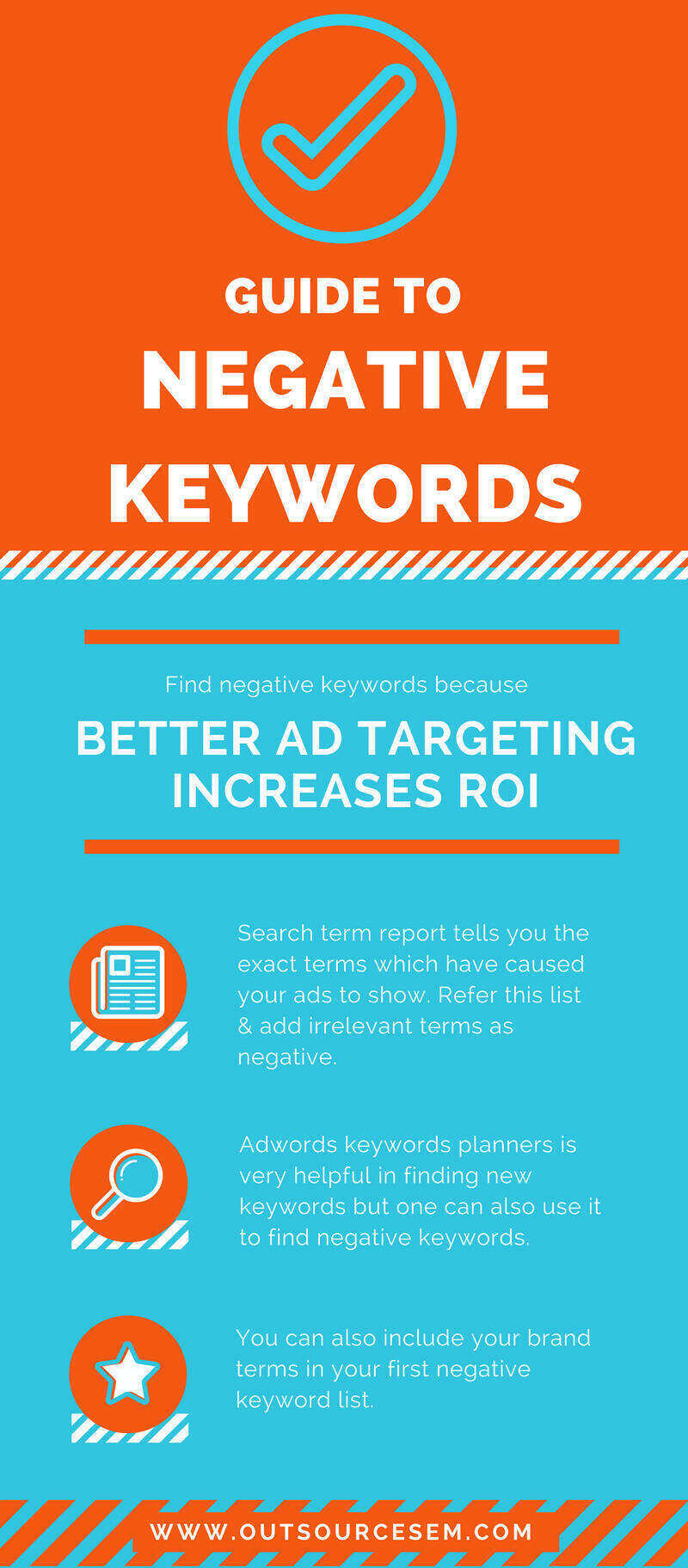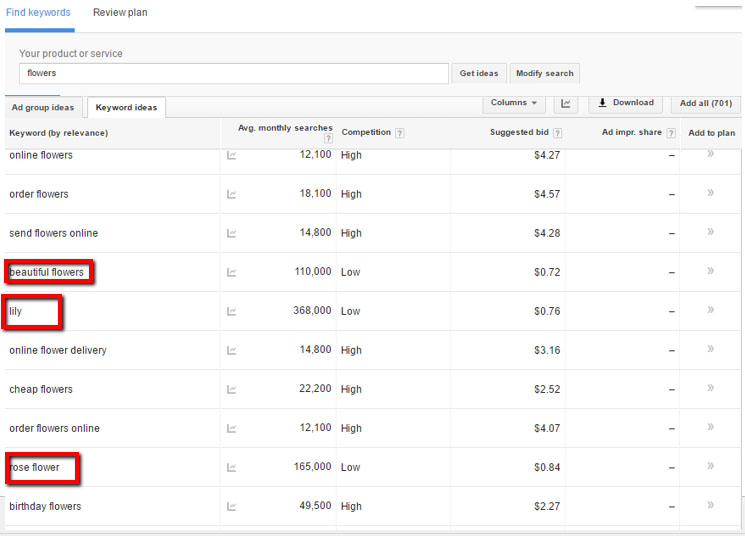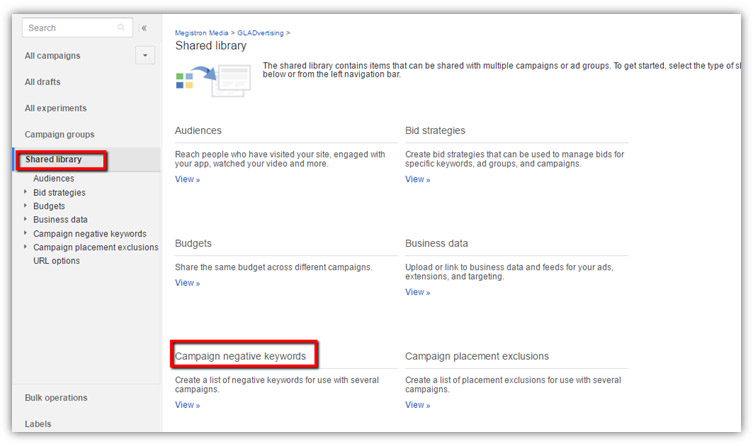Negative keywords lets you exclude certain terms for which you don’t want your ads to be shown. Better ad targeting can put your ad in front of interested users and increase your ROI. This feature helps you focus only on keywords that matters to your customers.
How they work
A keyword can target broad set of phrases, it’s important to see whether every term is related to your business.
For e.g. – let’s say you have a shop which delivers only lily bouquet. In that case you can add “rose bouquet” as negative keyword.
You can always analyze the search terms report and look for terms which are similar to your keywords but are irrelevant to the products or services that you offer.

How to find negative keywords
Search Query Report - You can always refer the search terms report to find negative keywords for your campaign. Search terms report tells you the exact terms which have caused your ads to show. You can always refer this list and choose the irrelevant terms for which your ads are showing and can add them as negative. It helps online marketers to reduce average CPC and consequently improve ROI. Therefore, we analyse search terms report and provide 100% White label PPC solutions to our clients. We also help our clients with there PPC reports and PPC campaign analysis so that they can make necessary improvements into there marketing campaign and keyword strategy.
For e.g. – You can sort results of search terms report by number of impressions or click and add the ones which are relevant to your business and exclude the ones which are irrelevant. This data can be further redefined to show which terms have higher click through and conversion rates. Also you can look into the keywords which you have previously added in the keyword list, some of them might have negative impact on the campaign performance. You can always add them as negatives.
Don’t apply too many negatives at once as it can harm your website rather than doing good especially if you have a very large account.
Finding Negative Keywords with Keyword Planner – As Google Ads keyword planner tool can be very helpful in finding new keywords for your campaign but one can also use it find negative keywords.
For e.g. - You are a florist who sells flower online. When you search for keywords like “flowers” in keyword planner tool. You come across lot of keywords which are not related to your business, like – “lily”, “beautiful flowers”, “rose flower” etc. these terms are very generic.
Adding Branded Terms as Negatives – You can also include your brand terms in your first negative keyword list. Doing so keeps your higher CPC non branded terms from poaching brand related impressions.

Adding Negatives to Search Network Campaign
• Sign in to your Google Ads account and click on the keywords tab.
• Below the keywords tab there are three options – “keywords”, “negative keywords” and “search terms”.
• Click on the negative keywords tab and you will see two tables “adgroup level” and “campaign level”.
• Add negative keywords at adgroup level or campaign level. After clicking +keyword button select the campaign or adgroup in which you want the keywords to be added.
You can also add negatives using AdWords editor tool.
Adding Negatives to Display Network Campaign
Negative keywords are not as precise in display campaign as they are in search network. Your ads may still appear on these terms.
• Sign in to your Google Ads account and click on the keywords tab.
• Under campaigns tab go to display network tab.
• Select the adgroup and select one from “Add campaign exclusion” and “Add adgroup exclusion”.
• And select display keywords from the dropdown menu.
• Add the negative keywords one per line and then click save.
Note: It’s always recommended to exclude site or categories rather than limiting the visibility of your ads.
Adding Negatives at Adgroup and Campaign Level
You can add negatives in two ways i.e. either at campaign level or an adgroup level. By adding negatives at campaign level you can restrict your ads to show for keywords in that campaign whereas by adding negatives at adgroup level you can restrict your ads to show for keywords within particular adgroup.
For e.g. - You are running campaigns for shoes and you want to keep separate campaigns for red shoes and you don’t want your generic ads to show up for this keyword, then you can add “red shoes” as negative in other adgroups.
Negative Keyword Match Types
Similar to keywords match types, negative keywords also has three different match types – broad, phrase and exact match.
• Negative broad match keywords – Let’s say you have added “pink flowers” as negative keyword, then any query which contains both “pink” and “flowers” will not trigger your ads. So when someone types “buy pink and red flowers” then your ad won’t be triggered.
• Negative phrase match keywords – Next is the phrase match negative keyword. Its works similar to phrase match keywords. Your ads will show only if the term “pink flowers” appears in the query as intact phrase. So if somebody types “where can I buy pink flowers”, then your ad won’t be shown.
• Negative exact match keywords – This is the least common negative keyword. Say for e.g. if you don’t want your ads to show for “flower”. You can add it as negative in exact match, so that your ads won’t show if someone searches “flower” but it will show if someone types “pink flowers” or “red flowers”.
Negative Keyword Libraries
It’s never easy to implement robust negative keywords list. Google Ads has shared library for this. You can use it to build comprehensive library set-up and share it across the campaigns or adgroups of your choice. You can reuse the list by quickly copying repeated themes to other accounts or campaigns.
So let me tell you how to add negative keywords in shared library –
• You can find “shared library” in the left navigation bar.
• Click on “Campaign negative keywords” and then click on “+list” tab.
• Name the list and start adding the keywords.


Impact of negative keywords on your campaign
There may be decline in impressions but who cares if your conversions has increased that too at lower cost per conversion. Not only this but it also improves your quality score and lower your cost per click. Also spend decreases as you stop getting irrelevant clicks.
